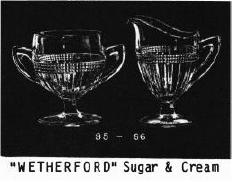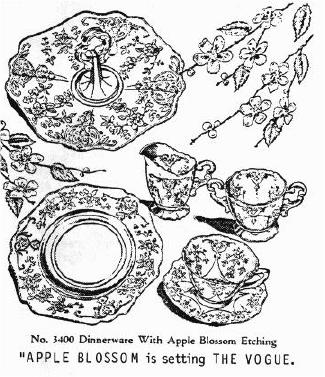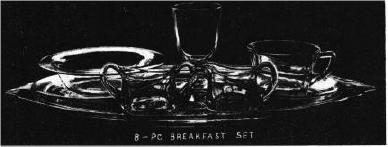Cambridge "Pinks"
by Mark A. Nye
Issue No. 207 - July 1990
During the 50 plus years the Cambridge Glass Company was in
business, four pink colors were used: Peach-Blo (later known as
Dianthus Pink), LaRosa, and Cambridge Pink, all three being transparent
 colors, and Crown Tuscan or Coral, the opaque pink shade brought out in
the early 1930s.
colors, and Crown Tuscan or Coral, the opaque pink shade brought out in
the early 1930s.
Since the theme for this year's Convention includes the color pink, I thought I would jump ahead a number of years in my current series of articles, dealing with early Cambridge production, and cover the early years of Peach-Blo production. Crown Tuscan was previously covered in two articles (published in the February and March 1986 C.B.'s). Some of the information presented here has been previously used in prior articles, but is necessary for the complete story of Peach-Blo, and may not be familiar to new readers.
Trade Journals do not mention Peach-Blo until the end of July 1925, thus indicating it was probably brought out at mid-year. The following comes from the August 3, 1925 issue of China, Glass and Lamps.
"An unusual number of lovely new things have arrived at the show rooms of the Cambridge Glass Co., at 184 Fifth Avenue, since my last visit. The most important is a new color in glass known as Peach-Blo. It is made up in stemware and in footed and straight sided tumblers, in wide optic, and may be had either undecorated or with an encrusted band and line treatment.
The color is absolutely unique in modern glass. It has the warmth and sparkle of amber, and the gayety of the Du Barry Rose, and is different from these, while combining the charms of both. The name - Peachblo - describes it perfectly."
The first reference to Peach-Blo in Crockery & Glass Journal appeared in the July 30, 1925 issue and was contained in a lengthy paragraph describing what was new in the New York showrooms.
". . . New stemware, graceful to a degree, has been worked out from the never failing resources of this prolific company. The line comes in amber, green, amethyst, crystal and peach blow, on a narrow optic shape with a new etched gold band in simple design. The peach blow by the way, is another innovation, an addition to the color list. It is delicate yet deep and rich and altogether lovely . . ."
The stemware referred to was probably the #3051 line, but the etching remains unidentified.
It is possible Cambridge was the first of the big handmade glass houses to introduce a pink color. Duncan & Miller brought out theirs in 1926, Fostoria introduced Rose or Dawn in 1928, Imperial's Rose Marie dates to the mid-1920s, and so on.
From China, Glass & Lamps of January 18, 1926, comes this item about Peach-Blo.
"In the new colored glass known as Peachblo, the Cambridge factory has two shapes in reproduction of old English glass and have been named the "Wetherford" and the "Stratford." The former has wide panels and straight lines while the latter is more intricate in design. The "Wetherford" shape also is shown in emerald, amber and amethyst in clear colored glass. Both the new patterns in the new 'Peachblo' glass also are shown with gold treatments including bands and encrustations."
 The cover of the March 29, 1926, issue of China, Glass & Lamps
carried a Cambridge advertisement that read.
The cover of the March 29, 1926, issue of China, Glass & Lamps
carried a Cambridge advertisement that read.
"GEISHA GIRL FLOWER HOLDER - a magnificent specimen of the glassworker's art - this unusual flower holder brings to the flower bowl a touch of true oriental beauty. Used on the console, the dining table and as part of the indoor garden in sun porch and living room. Many uses mean many sales means profits. Made in Emerald, Amber-Glo, Peach-Blo and Crystal; 12 inches high. Order by No. 523 and specify color desired."
"A REALLY CLEVER CANDY BOX" is how the lead line reads, in the Cambridge advertisement on the cover of China, Glass and Lamps, June 7, 1926. Illustrated was the #580 candy box with rose knob. Quoting from the text:
"Entirely new in candy boxes is the No. 580 with the unusual Rose Bud knob in color contrasting with the box and cover. This is only one of a number of shapes in this delightful box.
Supplied in Amber-Glo, Peach-Blo and Emerald. The Peach-Blo box has the knob in either Emerald or Amber-Glo and there are other contrasting selections."
Three weeks later, the Cambridge advertisement on the cover of this same trade journal featured a bridge set described in the lead-in, as "A BRIDGE SET SUPREME."
"For the bridge game or for the summer veranda, we offer The No. 623 five-piece handled high ball or bridge set, consisting of handled
tray and four tumblers. In the entrancing transparent shades of Amber-Glo, Peach-Blo and Emerald, this set can be made a real business getter. The tumblers can be supplied either plain or crackled."
In the July 8, 1926 issue of Crockery & Glass Journal was published this information regarding another new Cambridge item.
"One of the cleverest of the new items on the market is that shown by O. C. Graham, New York manager for the Cambridge Glass Co., at the concern's salesroom, 184 Fifth Ave. This is a glass compact set consisting of a bottom and cover in a fancy oblong shape. The lower part has recesses for rouge, powder and puff, eye brow pencil and lip stick. This is made in amber, green, peach-blo and crystal in polished or satin finish and comes in various decoration."
During the balance of 1926 and into 1927, Peach-Blo was mentioned quite regularly in the trade journals. On the cover of a February or March issue of China, Glass & Lamps appeared a Cambridge advertisement featuring a night set that was described as:
"A triumph in Cambridge Art Glass is this gold-encrusted Night Set composed of small covered jug, oval tray and tumbler. Supplied in Amber-Glo, Peach-Blo or Emerald."
Cambridge advertisements continued to appear on the cover of China,
Glass & Lamps and featured such items as the five compartment
relish dish, the #3075 cheese dish, square dishes for brick ice cream,
bookends, console sets and shakers, all of which were being made in
Peach-Blo and in most cases further decorated with etchings and gold
encrustations.  One of the new items brought out in 1927 and furnished
in Peach-Blo, as well as other colors, was the "Sani-Shaving Service,"
and this item was featured on the cover of the June 13, 1927 issue
of China, Glass & Lamps.
One of the new items brought out in 1927 and furnished
in Peach-Blo, as well as other colors, was the "Sani-Shaving Service,"
and this item was featured on the cover of the June 13, 1927 issue
of China, Glass & Lamps.
"Something entirely new and original is the 'Sani-Shaving Service,' entirely of glass in two pieces. The bottom portion is for safety razor, blades, cream, brush and styptic pencil. Ideal for the bathroom cabinet. In Cambridge colors of Amber-Glo, Peach-Blo and Emerald."
One week later, this item appeared in the same trade journal.
"Individual breakfast sets of amber, green and peach each equipped with an 18 inch glass tray to match are new and selling well at the Cambridge Glass Co., 184 Fifth avenue.
The 18 inch tray is of a size and shape that makes it available as a platter also which is a point to remember in selling the set to a thrifty housewife. The glass tray is fitted with the regulation cereal and plate, sugar and cream, egg cup and saucer. It certainly would start the day right to have breakfast appear at the bedside on one of these peach colored services."
Advertisements appearing in China, Glass & Lamps throughout the balance of 1927 continued to mention Peach-Blo. In a cover advertisement promoting a new stemware line (#3085), this text was used:
"In blown stemware in colored glass, CAMBRIDGE wares rightfully have a high place. The shape illustrated is new and graceful. Shown
are the goblet, tumbler and sundae. This is especially attractive in bowl of Peach-Blo and foot of Emerald. Also procurable in other combinations."
One of the big events in the history of Peach-Blo was the introduction of glass dinnerware. From the March 31, 1927 issue of Crockery and Glass Journal we have this contemporary account of this event.
"Among the host of lovely new items which the Cambridge Glass Co., Cambridge, O., are featuring at their New York showroom, 184 Fifth Avenue, is an open stock table service, which is one of their latest surprises offered to the trade. This is most complete and includes every imaginable item. Oval plates in six different sizes, open and covered dishes, large and after dinner coffees, sugar and cream, bouillons and cream soups are only a few of the pieces shown. The decorative treatments these are offered in are a revelation. A selection of five gold encrustations, and two etchings, as well as the plain glass are exhibited on colors of amber, green and peach. The decorative schemes employed are reproductions of the Dresden Rose, border encrustations and fanciful etchings."
This table service was the Round Line; and etchings to be found are #520 and #704.
Later came the Decagon Line and the #3400 Line, both of which were made in Peach-Blo and came in a full dinnerware line.
"There is a stunning new patented Decagon shape now being exhibited by the Cambridge Glass Co. ....at their New York display room... The keynote of the success of this progressive factory is originality and in this ten-sided shape they are certainly offering something of unusual appeal. It is particularly adaptable to the
bowls they are showing in a selection of either bell, cupped or rolled edges in colors of either emerald or peach ..."
One of the etchings used on Decagon blanks, and probably the most popular, was Cleo; and today, Peach-Blo Cleo is one of the collectible Cambridge patterns. From China, Glass & Lamps, May 20, 1929, comes this description of a luncheon set that had just been introduced by Cambridge.
"In their attractive Decagon design the Cambridge Glass Co., Cambridge, O. has announced a 21-piece luncheon set which should be most suitable for June and summer merchandising. The set is composed of six cups, six saucers, six salad plates, sugar, creamer and handled cake or sandwich tray, comprising complete service for a table for six. The Decagon shape in Cambridge glass is exceptionally well designed and fits in with the demand for wares which can be used with either Colonial or Spanish settings. The illustration shows the set in the Cleo pattern etching. This is an exceptional pattern and has proved popular in stemware. The luncheon set is made in Willow Blue, an unusual shade of blue; in Peach-Blo, a unique shade of pink; and Emerald, a green of spring time freshness ....."
 In 1930, Cambridge brought out their #3400 Line and among other
etchings Apple Blossom.
In 1930, Cambridge brought out their #3400 Line and among other
etchings Apple Blossom.
"APPLE BLOSSOM is setting THE VOGUE.
Visualize this lovely table setting. Consider the interest it will arouse among your customers and the sales it will bring. Apple Blossom, adaptable to dozens of beautiful table combinations, gives you in one consistent theme, a quality stemware, dinnerware, novelties and flat pieces in a selection of delicate and striking colorings in attractive design. There is peach, emerald, amber, crystal, or willow blue and our recent innovation, the new Gold Krystol. Call at our nearest showroom, where you will find complete samples awaiting you. Apple Blossom is not expensive -- you will be agreeably surprised. Advertising mats supplied to assist your sales." From China, Glass & Lamps, September 1930.
Today, Apple Blossom in any of its colors, including Peach-Blo, is a top rated Cambridge collectible and in much demand. I am quite sure buyers from 1930 would certainly be surprised by the prices Apple Blossom commands today.
Also new in 1930 was the etching Gloria; and the following was taken from the October 1930 issue of China, Glass & Lamps.
"Gloria is the name which the Cambridge Glass Co. has given to its newest decoration and it is to be seen at the showrooms, 184 Fifth Avenue. As the illustration shows, the Gloria is a floral pattern of the most distinctive character. One unusual feature is the fact that
the design begins at the bottom of the piece and extends upward, instead of starting at the top and working downward as is more customary.
A full line of dinnerware, flatware and stemware may be had in this decoration, and it has been developed in amber, green, pink, gold krystol, willow blue and crystal. In the illustration, the pattern is shown on Cambridge's new patented "3400" square plate, a shape which is proving most attractive to all buyers who have seen it ....."
Color continued to play an important role in the Cambridge line and among the colors that continued in the line was Peach-Blo. In 1934, the name was changed to Dianthus Pink, perhaps as the result of some legal difficulties with name Peach-Blo. However, as the 1930s progressed and then drew to a close, the use of color was declining throughout the glass industry and after 1935, new lines coming from the Cambridge factory, except for Caprice, were seldom, if ever produced completely in color as well as crystal.
Peach-Blo or Dianthus Pink, as it was then known, was discontinued, along with many other colors, in 1943 due to the shortage of raw materials.

